【Abstract】 Objective Through a retrospective study, to observe the cl inical therapeutic effect for closed reduction
treatment of developmental dislocation of the hip (DDH), and to dynamically analyze characteristics of acetabular development after closed reduction in DDH. Methods A total of 100 single side DDH children who were treated by “the treatment mode of closed reduction” from January 2002 to December 2005 were followed up, including 18 males and 82 females, with the average age of 19.4 months (ranging from 7 months to 36 months). Sixty-eight patients had left side dislocation, while 32 had right side dislocation. According to Zionts dislocation grades, 15 cases were degree I, 50 degree II, 26 degree III and 9 degree IV. Adductor tenotomies and skeletal traction were carried out in 74 cases, while direct closed reduction was performed in 26 cases. The four-level functional evaluation criterion was used to assess the cl inical therapeutic effect. Lesional and homeochronous normal hips were paired, and acetabular index (AI) and AI (D/W) of lesional and normal hips, before the reduction and in the 3rd, 6th, 9th and 12th month, respectively, after the reduction, were dynamically measured. Results The total choiceness rate of 100 children was 88.00%. Twelve months after the reduction, lesional AI decreased from (37.17 ± 2.17) º to (27.02 ± 3.54) º, while lesional AI(D/W) increased from 22.06% ± 1.65% to 29.80% ± 3.56%, and the differences among each time-point had statistical significance (P lt; 0.01). Both rates of lesional AI decrease and AI(D/W) increase were obviously faster than those of normal side physiological development (P lt; 0.01). In all durations after 12 months reduction, the rates of lesional AI were (3.22 ± 1.42) º and (3.41 ± 2.03) º in 1 - 3 months and 10 - 12 months , respectively, and the rates of AI(D/W) were 2.69% ± 1.83%
and 2.33% ± 1.13%, respectively, and they were obviously faster than the other durations (P lt; 0.01). Both rates of lesional AI decrease and AI(D/W) increase were obviously faster than the homeochronous rate of normal side physiological development in each duration (P lt; 0.01). The rates of lesional AI were (13.71 ± 3.96) º and (11.48 ± 4.15) º in 7 - 12 age group and 13 - 18 age group, respectively, and the rates of AI(D/W) were 9.95% ± 3.81% and 8.28% ± 3.58%, respectively, and they wereobviously faster than the other age groups (P lt; 0.05). Both changes of lesional AI and AI(D/W) were obviously faster than the homeochronous changes of normal side in each age group(P lt; 0.01). Conclusion There are simple operating requirements and fine therapeutic effect of “the treatment mode of closed reduction” . Within 12-month after the closed reduction treatment, the rate of lesional acetabular development is obviously faster than that of normal side physiological development. The cresttime of lesional acetabular development is during 1 - 3 months and 10 - 12 months, and the best treatment time of closed reduction is the age before 18 months.
Citation: LI Gang,LIN Qingjian,HUANG Changhong,FENG Yang,WANG Biao. A STUDY OF ACETABULAR DEVELOPMENT AFTER CLOSED REDUCTION IN DEVELOPMENTALDISLOCATION OF THE HIP. Chinese Journal of Reparative and Reconstructive Surgery, 2008, 22(6): 657-661. doi: Copy
Copyright © the editorial department of Chinese Journal of Reparative and Reconstructive Surgery of West China Medical Publisher. All rights reserved




